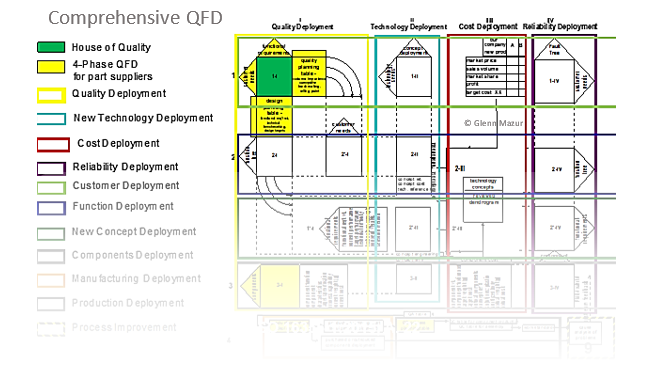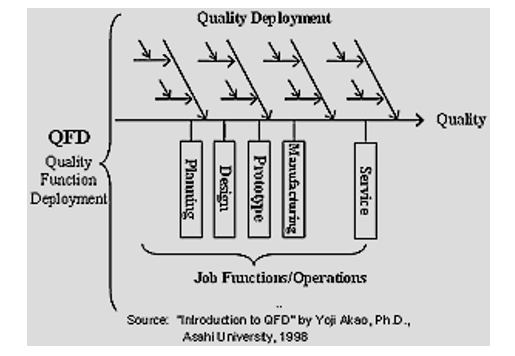"Toyota chief apologizes for global recalls," read a headline in the Associated Press and everywhere in the US. [Feb. 5, 2010]. This followed a series of recalls by the automaker in recent years, including the 2007 recall of 533,000 Toyota Sequoias and Tundras for a defect in the steering system and more seriously, an incident in 2006 that resulted in a Japanese government investigation of company executives for intentionally delaying a warranty recall. [November 2006, Nihon Keizai Shinbun]
Sony, Toshiba, and Mitsubishi Fuso are also among the industry leaders who have had a serious quality recall recently. In the U.S., major restructures were played out at GM and Chrysler who were once pioneers in 1980s in adopting Japanese quality methods including Quality Function Deployment (QFD).
There is a lesson: Quality is fragile... Any golden standard can fall when it retains the status quo, and this includes a company of unfaultable reputation.
So, it was timely to receive this question from one of our readers. He has been doing the “4-phase model QFD” process for over 15 years, leading QFD workshops and DFSS projects and earning a Six Sigma Black Belt:
"Why should I need to start all over from the QFD Green Belt® level? Why can’t I jump in the QFD Black Belt® program?"
This is a legitimate question that should not be treated lightly. The legacy issue, in fact, is one of the reasons why the QFD Belt Certificate program was created. It also raises the issue why it is imperative for today’s business to update their quality practices, especially QFD.
History
The “4-phase model QFD” and "4-house model" refers to the over-simplified, over-extracted version of the Japanese Comprehensive QFD. The 4-phase / 4-house model was developed by the U.S. auto industry in the 1980s in order to address the competitive threat of Japanese carmakers. They truncated the original QFD so that the U.S. auto suppliers (who were in build-to-OEM-print business) could hastily imitate what their Japanese competitors were doing. But they pared down and simplified the method and tools so much without understanding the spirit, that the creators of the 4-phase QFD model actually dubbed it "kindergarten QFD" because its simplicity was meant to be only a starting level, not a graduate course.
Unfortunately, many who were exposed to this early truncated model never moved beyond the "kindergarten" point, never upgraded their learning, and probably do not even realize that their QFD knowledge is only a fragment of the real QFD process. In the early days of QFD introduction to the West, these 4-phase application case studies published in the 1980-90s by the U.S. auto industry became the exclusive source of QFD information for non-Japanese scholars and practitioners, who then wrote the first-generation of QFD books and articles in English. Over time, their books and examples became the main source of QFD informationfor still others seeking QFD information in English, perpetuating this QFD mis-information.
Why update your QFD now?
The 4-phase / 4-house model QFD wrongly assumes that a House of Quality (HOQ) matrix is QFD. The HOQ matrix is one of the 7 Management Tools used in various quality studies, not just in QFD. It is a powerful tool when properly used. A House of Quality matrix is not QFD in itself, and in many QFD projects, it is unnecessary.
Building a HOQ correctly takes considerable time, resources, and skill, so should yield more benefit than the effort. Implementation errors are frequent even in the hand of a Six Sigma Black Belt coach.
HOQ originally began in Japan in the 1960s when lifetime employment afforded Japanese companies abundant human resources. But today's lean organizations make it difficult to secure the resources needed to complete this detailed matrix study from initial project planning through quality assurance and control activities. Many practitioners, expressing that they would like to do more QFD than they have time for, resolve the issue by quitting in the middle.
Dr. Akao, founder of QFD, bemoaned these circumstances and authorized the QFD Institute in 2000 to create a more efficient model for modern Western companies. The QFD Institute’s QFD Belt program was thus created.
The QFD Green Belt® and QFD Black Belt® address the issues discussed above and more. The intent of the QFD Belt program is to help your business efficiently identify market opportunities and customer value, incorporate innovative changes in your product/service development process, and become poised to generate profits through the transformation brought by QFD, as well as build internal human resources that can carry out future QFD projects.
And just as many good ideas and systems do, QFD continues to evolve. Most notably, QFD has made into the ISO standard 16355, thanks to the efforts of many international QFD experts. This standard spells out important tools and steps of modern QFD method. It also includes legacy QFD approaches such as the House of Quality and 4-Phase method but with important updates. Specifically, the ISO standard specifies that you use modernized ratio scale math and not 1-3-9 priority rating, even if you are still using the classical House of Quality or 4-Phase method—one more reason for you to update your skills and knowledge now. (Read "Classical QFD, Blitz QFD®, or Reverse QFD... Which one for my project?")
Why prerequisites for the QFD Black Belt® course?
The goal of the QFD Green Belt® course is to introduce the main tools of Modern QFD with some hands-on practice. The goal of the QFD Black Belt® course is to learn how to apply these tools and lead others on real projects. The two courses have little overlap. Without solid understanding of Modern QFD from the QFD Green Belt® course, one would not be able to follow the fast-paced QFD Black Belt® course which covers over 1,200 pages of advanced materials. If your QFD exposure is limited to the 4-phase model, you will not be able to get as much out of the QFD Black Belt® course because you will most likely have difficulty grasping the basic modern tools.
The QFD Green Belt® and QFD Black Belt® courses have been attended by senior QFD practitioners as well as first-timers, including veterans who have been doing the 4-phase QFD since the 1980s and have even written QFD books. One such long time QFD expert recently attended our QFD Green Belt® and QFD Black Belt® course and exclaimed, "Until I took this course, I did not know that the QFD knowledge I had learned previously from other sources was wrong even though I had written a book about QFD. Now it makes sense."
The challenges your business faces today are different from even three years ago. Shouldn’t your response change, too?
The QFD Belt program goes through rigorous reviews at least twice a year, to assure the materials and teaching methods reflect today’s best practice and global business trends. The benefit to those who attend our QFD Belt Courses is the cutting-edge QFD knowledge and application technology that we share from this continuous improvement and research. In fact, Dr. Akao even recommends to the Japanese that they take the QFD Green Belt® course. These courses also include Modern QFD templates for these new tools and math, as well as a basic AHP and modernized House of Quality templates.
Past attendees can continue to update their knowledge and get semi-private coaching through the QFD Green Belt® Update Course and QFD Black Belt® Update Course .


